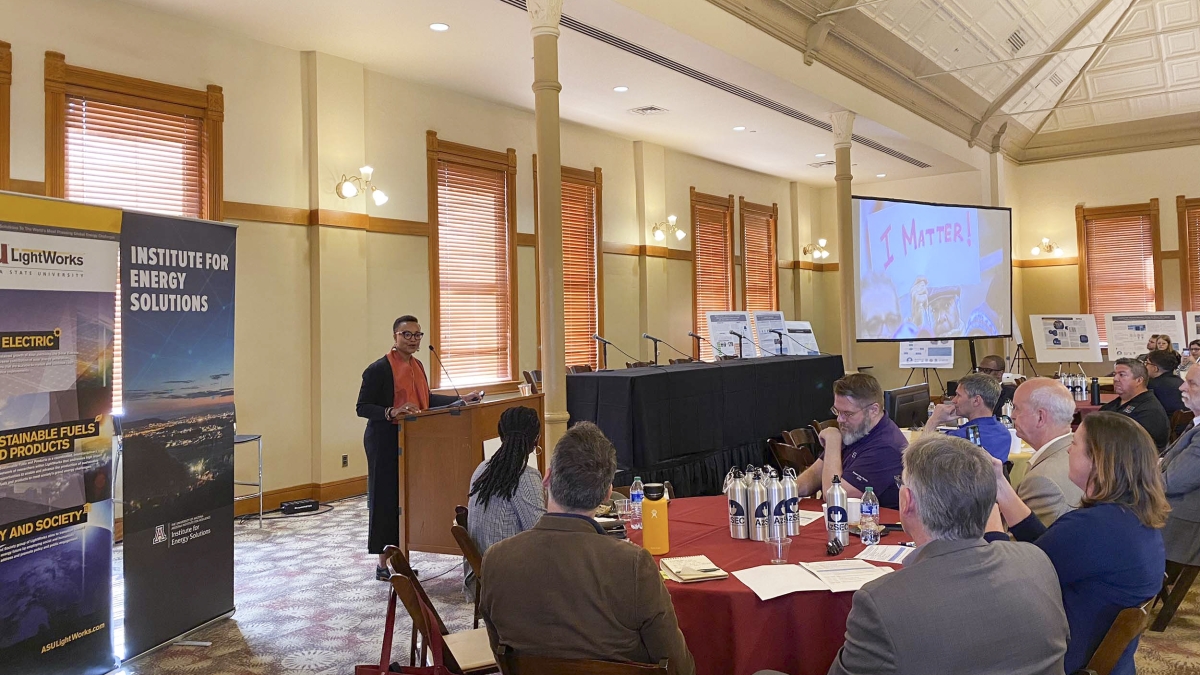Encouraging state university collaboration in renewable energy

Shalanda H. Baker, director of the U.S. Department of Energy’s Office of Economic Impact and Diversity, addresses the attendees of the Arizona Student Energy Conference held at Arizona State University. Photo by TJ Triolo/ASU
Shalanda H. Baker, director of the U.S. Department of Energy’s Office of Economic Impact and Diversity, told attendees of the Arizona Student Energy Conference: “It’s really special to be in a room full of students. You’re very much the future, and the things that you will get to do to transform our energy system into one that is more just and equitable, I can’t even begin to imagine.”
Baker was the keynote speaker at the conference, or AzSEC, which held its 12th annual event in early April in Old Main on Arizona State University’s Tempe campus.
This year’s theme was making the transition to renewable energy equitable and inclusive. Baker also emphasized that the transition to renewable energy should not leave out low-income and minority groups.
In addition to panels and the keynote, the conference hosted activities to engage students, industry members and academics such as practicing writing research proposals and hosting poster competitions showing students’ energy discoveries.
Stephen Goodnick, the David and Darleen Ferry Professor of Electrical Engineering in the Ira A. Fulton Schools of Engineering at ASU, and Neal Armstrong, the Regents Professor Emeritus of chemistry at the University of Arizona, formed the conference in 2010 for students from the two universities to meet and exchange research findings and ideas related to the renewable energy sector.
“We needed to be working as a state, not individual universities competing against each other,” said Goodnick, a faculty member in the School of Electrical, Computer and Energy Engineering, part of the Fulton Schools.
The conference also includes Northern Arizona University, which joined AzSEC a few years after it began; hosting duties rotate between the three universities. The universities complement each other’s geographic sustainability specialties, such as NAU’s focus on harnessing northern Arizona’s wind for electricity, while ASU and UA specialize in harnessing the desert’s plentiful sun for solar power.
Originally funded through the Arizona Board of Regents Technology and Research Initiative Fund, the conference is now supported by utility companies in Arizona, including the Salt River Project, or SRP, Arizona Public Service, or APS, and Tucson Electric Power, as well as energy industry companies such as Schneider Electric. Representatives from the companies participate in industry panels that give students networking opportunities and insight.
Electrifying student, industry connections
Tom Acker, a senior principal engineer in innovation and development at SRP, originally got involved in AzSEC as a NAU faculty member specializing in renewable energy.
After retiring from the university, he began working at SRP. Acker’s department at the company is a longtime supporter of the conference.
This year, Acker gave opening remarks and moderated the industry panel on career paths in power and energy. He says the conference helps industry members identify students for potential internships and jobs.
“The electrical energy system is going through a big transformation to renewables, and we need talent to help us in that transition,” Acker says. “We need everyone to understand what that transition is.”
He says the conference also gives SRP a chance to advance their efforts in corporate social responsibility.
“We believe in the future of our community and of the environment,” Acker said. “We believe in energy justice, and this is a forum where we can see what’s going on at the universities, and we can build those relationships that help us get to those goals.”
Powering up connectivity for energy projects
Goodnick’s mentee Maxx Patterson, a sustainable energy doctoral candidate in ASU’s College of Global Futures’ School of Sustainability, has attended multiple years of AzSEC and sees the event as a unique chance for students from universities across the state to make important connections.
“I referred one individual I spoke with from another university to contacts at APS and SRP,” Patterson said. “When we met, he told me who he hoped to connect with, and I was able to point him in the right direction.”
As part of the student organizing committee, Patterson’s involvement includes planning event logistics and running the research pitch showcase.
AzSEC also provided Patterson the opportunity to meet officials from institutions not easily accessible to students otherwise, such as the National Renewable Energy Laboratory.
“Now that I’ve met people in prominent organizations like that, I can call on them as a reference,” he said. “That kind of connectivity is valuable for my career.”
To learn more about the AzSEC conference, visit the website or contact event coordinator Ruby Sayed at robina.sayed@asu.edu.
More Science and technology

ASU-led space telescope is ready to fly
The Star Planet Activity Research CubeSat, or SPARCS, a small space telescope that will monitor the flares and sunspot activity…

ASU at the heart of the state's revitalized microelectronics industry
A stronger local economy, more reliable technology, and a future where our computers and devices do the impossible: that’s the…

Breakthrough copper alloy achieves unprecedented high-temperature performance
A team of researchers from Arizona State University, the U.S. Army Research Laboratory, Lehigh University and Louisiana State…

